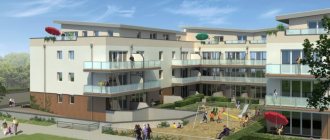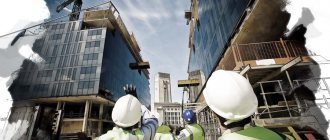Legislative regulation of the issue
Art. 164 of the Housing Code of the Russian Federation states that the basis for contracts concluded with this method of managing an apartment building is the decision of the apartment owners , adopted at a general meeting.
Residents must take care of their relationships with public utilities (supply and removal of hot and cold water, electricity, gas, heating, etc.) on their own.
The use of an electronic form of a document assumes that the citizen will place the agreement in the appropriate system.
Minimum number of apartments
The transition to direct management of an apartment building is regulated by Art. 164 of the Housing Code of the Russian Federation. The possibility of such leadership is a guarantee of the full functioning of the community of citizens. As practice shows, homeowners mostly interact directly with service providers in rural areas. In such conditions, large-scale multi-apartment development is often not envisaged.
In buildings where the number of apartments is less than 12, the owners of the living space are exempt from the need to enter into an additional agreement with third-party contractors who will provide services for repairing and maintaining the normal condition of the apartment building.
If there are more than 12 apartments in a building, some procedures become more complicated. To approve the decision, more than 50% of the votes of all homeowners must be collected. Only then can their expression of will be considered legitimate.
Readers of legal portals are often interested in how many apartments there should be in a building for direct management. This nuance is regulated by Art. 161 Housing Code of the Russian Federation. In order for residents of an apartment building to use the service directly, the building must have at least 13 apartments, but no more than 30.
The management of the house is carried out by all owners of the living space personally or through an intermediary. The latter may not live in the apartment building, where a direct form of leadership is provided.
The optimal option for home maintenance is management of apartment buildings of up to 30 apartments. It is difficult to attract a larger number of residents to participate in the meeting. It is even more difficult to reach agreement.
Last changes
With the latest change in housing legislation, a rule was introduced according to which the management company is only partially responsible for poorly performed services .
New edition of Art. 157 of the RF Housing Code says that the presence of evidence of the impossibility of correcting the situation allows one to evade responsibility. Simply put, with rusty water, no one has done anything, and no one will do anything.
The absence of intermediaries in the management of an apartment building assumes that residents will independently deal with :
- maintenance of general premises;
- reconstruction work and ongoing repairs;
- distribution of funds.
To make a decision on a particular issue, residents must organize a collective meeting . Voting can be either absentee or in-person. In the same way, it is possible to appoint a trustee, whose duty will be to represent the interests of the main number of residents in the house.
In accordance with Russian legislation, a HOA may include 1 residential building, several buildings or an entire block. This form of management requires that decisions are made at collective meetings, and the board is headed by a chairman.
Improvement of the adjacent territory and ongoing repairs are allowed either to be carried out independently or to enter into labor agreements with the relevant teams or contractors.
A housing cooperative is another form of management of an apartment building. The organization is an independent legal entity, consisting of a chairman and owners of real estate.
Among the features of such management are:
- permission or prohibition on renting common premises;
- individual rules for counting votes;
- regulatory legal acts do not contain any information regarding the procedure for such management, that is, the housing cooperative can come up with them themselves and include them in the Charter.
Russian laws state that apartment owners can independently choose and change the way they manage the building where they live. But, if they were unable to come to a consensus within 1 year, then the local government body will do it instead through an open competition.
The Housing Code of the Russian Federation (Part 2, Article 161) provides for three ways to manage an apartment building (MCD):
- direct management by owners (no more than 30 apartments);
- management of a management company (MC);
- management of a homeowners' association (HOA) or a housing construction cooperative (HCS) or other specialized consumer cooperative.
The management method is determined by the general meeting of owners of apartment building premises and can change it at any time based on its decision.
A homeowners' association is not the most common way to manage apartment buildings, however, it is considered one of the most effective.
The HOA is a non-profit organization and is recognized as one of the organizational and legal forms of a real estate owners' partnership (TSN) (Article 135 of the Housing Code of the Russian Federation).
TSN is a voluntary association of property owners (premises in a building, including an apartment building, or in several buildings, residential buildings, garden houses, garden or vegetable plots of land, etc.), for joint ownership, use and disposal of common property .
Unlike TSN, only owners of premises in an apartment building or several apartment buildings or in residential buildings can unite in an HOA.
The term TSN appeared in September 2014 and did not abolish the concept of HOA. The creation and activities of HOAs, the legal status of its participants are still regulated by the norms of housing legislation, which are special in relation to the general provisions of civil legislation on HOAs (clause 21 of the Resolution of the Plenum of the Supreme Court of the Russian Federation dated 06.23.2015 N 25; Letter of the Ministry of Construction of Russia dated 10.04 .2015 N 10407-АЧ/04).
In the Stavropol Territory, about 860 HOAs have been created and operate to service and manage the housing stock.
Pros and cons of HOAs
It is believed that partnership is one of the most effective ways of management. First of all, because it includes the owners of the premises in the house themselves and they are interested in keeping the house in good condition: they decide for themselves when to carry out certain work in the house, decide on the source of their financing, and are free to choosing a contractor, have direct control over economic activities, and quickly solve problems that arise in the house.
An HOA, unlike a management company, is not a commercial enterprise and does not pursue the goal of its activities to make a profit.
An HOA can accumulate funds for major repairs in a special MKD account (clause 2 of Article 175 of the RF Housing Code), which also provides certain advantages. You can carry out major repairs ahead of the deadline established by the regional program, choose the contractor yourself and monitor the progress of the work.
The partnership pays utility bills to suppliers directly from its bank account - this minimizes costs and eliminates the possibility of incurring debt over a long period.
In addition, the organization has the right to rent out or rent part of the common property in order to generate additional income, which can be used for the improvement and repair of apartment buildings or to reduce the costs of maintaining the common property using these funds.
Another important fact noted by realtors is that housing in such houses is more liquid.
There are also disadvantages. The most important thing is the risk of error in the candidate for the post of chairman. It is not a fact that it will be reliable and the approach to managing the house will not be formal. To avoid getting into such a situation, you need to be civically active. Attend all homeowner meetings and regularly request partnership reports.
HOA for active owners who are ready to independently resolve financial issues, handle claims with defaulters, organize major repairs, monitor the execution of work, etc. Many people hesitate to create an HOA because they are afraid of responsibility.
Regulatory framework
The main documents regulating the activities of the HOA in managing apartment buildings, maintaining common property and providing utilities, just as in the case of managing a management house, are:
- Housing Code of the Russian Federation;
- Rules and norms for the technical operation of the housing stock (Resolution of the State Construction Committee of the Russian Federation dated September 27, 2003 No. 170)
- Rules for carrying out activities for managing apartment buildings (Resolution of the Government of the Russian Federation dated May 15, 2013 No. 416)
- Rules for the maintenance of common property in apartment buildings (Resolution of the Government of the Russian Federation of August 13, 2006 No. 491)
- Rules for the provision of public services (Resolution of the Government of the Russian Federation dated May 6, 2011 No. 354).
Owners of premises in one apartment building can create only one HOA. The decision to create it is considered adopted if the owners of the premises in the relevant building, who have more than fifty percent of the votes of the total number of votes of the owners of the premises in such a house, voted for it (Article 136 of the Housing Code of the Russian Federation).
The minutes of the general meeting, at which decisions were made on the creation of the HOA and on the approval of its charter, are signed by all owners of the premises who voted for the adoption of such decisions.
An HOA for several apartment buildings can be created if these houses are located on land plots that have a common border and within which there are networks of engineering support and other infrastructure elements that are intended for joint use by the owners of the premises in these houses. At the same time, the decision to create a HOA, approve the charter, select members of the board, a person authorized to represent the interests of the owners and select the chairman of the HOA are made at general meetings of the owners of premises in each building by a majority of at least two-thirds of the votes of the total number of votes of the owners of the premises in these houses.
The governing bodies of the HOA are the general meeting of the HOA members and the board of the partnership.
General meetings
The general meeting of HOA members is the highest governing body of the partnership and is convened in the manner established by the charter of the partnership to resolve issues of the functioning of these associations.
Not to be confused with the general meeting of owners (GMS) of premises in an apartment building!!!
The general meeting of HOA members does not have the right to resolve issues that fall within the competence of the HOA. For example, the creation of a HOA and the adoption of its charter is the prerogative of the general meeting of owners of an apartment building, and changing the charter is the prerogative of the general meeting of HOA members. The competence of the OSS also includes the following issues:
- on the reconstruction of apartment buildings, construction of outbuildings, major repairs;
- on the limits of use of the land plot;
- on the use of common property of the house by third parties.
Within the framework of the general meeting of HOA members, decisions are made on such issues as:
- reorganization and liquidation of HOAs;
- election of members of the board, members of the audit commission, chairman of the board of the HOA (if provided for by the charter);
- establishing the amount of mandatory payments and contributions of HOA members;
- approval of the procedure for the formation of the reserve fund of the HOA, other special funds of the partnership (including funds for current and major repairs of common property in apartment buildings) and their use, as well as approval of reports on the use of such funds;
- making decisions on obtaining borrowed funds, including bank loans;
- determining the directions for using income from the economic activities of the partnership;
- approval of an annual plan for the maintenance and repair of common property, a report on the implementation of such a plan:
— approval of estimates of income and expenses of the partnership for the year, reports on the implementation of such estimates;
— approval of the annual report on the activities of the board of the partnership;
— approval of the conclusion of the audit commission (auditor) of the partnership based on the results of the audit of the annual accounting (financial) statements of the partnership;
- consideration of complaints against the actions of the board, chairman of the board and audit commission;
- adoption and amendment, upon the proposal of the chairman of the board, of the internal regulations of the partnership in relation to employees, regulations on remuneration for their labor;
- determining the amount of remuneration for members of the board, including the chairman of the board.
The general meeting of HOA members has the right to resolve issues that fall within the competence of the board of the association.
Homeowners Association Charter
The HOA charter is the main document on the basis of which all activities in the partnerships are built, namely the relationship between the partnership and the residents of the house.
The HOA charter must indicate:
- the name of the partnership, including the words “association of homeowners”, location, subject and purpose of its activities;
- the procedure for the emergence and termination of membership in the HOA;
- the composition and competence of the management bodies of the partnership and the procedure for making decisions by them, including on issues on which decisions are made unanimously or by a qualified majority of votes;
- composition and competence of the audit commission or auditor of the partnership.
In cases where this does not violate the rights and legitimate interests of the owners, the partnership has the right to:
- provide for use or limited use of part of the common property;
- build on, rebuild part of the common property (in accordance with the procedure established by law);
- receive for use or receive or acquire land plots into common shared ownership of the owners for the construction of residential buildings, construction of outbuildings and other buildings and their further operation;
- carry out, at the expense of the owners of premises in the apartment building, the development of allocated land plots adjacent to such a house;
- enter into transactions and perform other actions that do not violate the law.
Membership in the HOA arises from the owner of the premises in the apartment building on the basis of an application to join the partnership.
At the request of the owners, regardless of membership in the HOA, the board:
- provides information about its activities;
- fulfills requirements regarding the quality of public services and performance of work;
- provides documents for review (HOA charter, register of partnership members, minutes of meetings, financial reports, estimates of income and expenses, reports on their implementation, technical documentation, etc.)
Rights and obligations of the HOA
The Partnership has the right:
- enter into an apartment management agreement and other agreements ensuring the management of the house, including the maintenance and repair of common property;
- determine an estimate of income and expenses for the year (costs for the maintenance and repair of common property, for major repairs and reconstruction of apartment buildings, special contributions and deductions to the reserve fund, for other purposes that do not contradict the law and the charter of the HOA);
- establish the amount of payments and contributions for each owner in proportion to his share in the right of common ownership of common property;
- perform work for owners and provide them with services;
- use loans provided by banks;
- select contractors and pay for their services;
- sell and transfer for temporary use, exchange property belonging to the partnership.
The responsibilities of HOA members include:
- maintain order in the house, cleanliness and safety of common property;
- represent the legitimate interests of premises owners;
- maintain a register of members of the partnership;
- prevent or stop actions of third parties that are contrary to the interests of the owners.
Powers of the HOA board
The HOA board elects the chairman of the partnership from among its members.
The charter of the HOA must establish the term of office of the board and its chairman, as well as the audit commission of the HOA. The maximum term of office is 2 years.
The HOA board has the right to make decisions on all issues of the partnership’s activities, with the exception of issues falling within the exclusive competence of the general meeting of owners of premises in the apartment building and the competence of the general meeting of HOA members.
The powers that are legally assigned to the HOA board:
- draw up estimates of income and expenses of the partnership for the corresponding year, reports on financial activities;
- conclude contracts for the management of apartment buildings.
- hire and fire workers to maintain apartment buildings.
- enter into contracts for the maintenance, operation and repair of common property in apartment buildings.
- maintain a register of partnership members, office work, accounting and financial statements.
- convene and hold a general meeting of members of the partnership.
Powers of the chairman of the HOA board
The chairman of the board of the HOA ensures the implementation of the decisions of the board and has the right to give instructions and orders to all officials of the partnership, the execution of which is mandatory for these persons.
Chairman of the Board of the Homeowners Association:
- signs payment documents and makes transactions that do not require mandatory approval by the board of the partnership or the general meeting of members of the partnership;
- develops and submits for approval to the general meeting of members of the partnership the internal regulations of the partnership in relation to employees, regulations on remuneration for their labor;
- approves other internal documents of the partnership.
Manager at HOA
A manager can be a person (individual or legal) who is hired to perform management and administrative functions for the maintenance and repair of common property in an apartment building. The manager does not have to own property in the apartment building and be on the board of the HOA.
The manager takes office by mutual agreement of the parties; a civil law or employment contract can be concluded with him. In an HOA, the decision to hire a manager is most often made by the board or chairman.
Audit Commission (auditor) of the HOA
The HOA's audit commission cannot include members of the association's board.
HOA Audit Commission:
- conducts audits of the financial activities of the partnership at least once a year; presents to the general meeting of members of the partnership a conclusion based on the results of the inspection;
- presents to the general meeting of members of the partnership a conclusion on the estimate of income and expenses for the corresponding year of the partnership and a report on financial activities and the amount of mandatory payments and contributions;
- reports to the general meeting of members of the partnership on its activities.
Thank you for your attention!
In the next lesson we will cover the topic:
“How to get a recalculation of fees for housing and communal services?”
What it is
This event has the following goals :
- preserve the property of citizens;
- organize security;
- ensure accessibility of objects related to common buildings;
- protect the interests of residents;
- Maintain metering devices and utilities in good condition.
Any important or global decision must be made at a general meeting of residents. The results are set out in a protocol, which is signed by each owner.
To increase efficiency, you can create a special council that will perform certain functions:
- prepare general meetings;
- control the implementation of decisions made;
- present the results of the work done to the owners.
Only the owners of housing in an apartment building can be the chairman and members of the council.
Advantages and disadvantages
Direct control offers the following advantages :
- The ability to independently decide what to do with your property. Other forms assume that issues of carrying out repair work, distribution of finances and many others are resolved by the controlling organization.
- Availability of legal grounds for refusal of any public resource.
- Individual responsibility for relationships with resource supply organizations. That is, if one of the owners, for some reason, is unable to pay utility bills, then the shutdown of water, gas or heat supply will affect him.
- Savings on management, since apartment owners do not have to pay management companies or cooperatives.
Despite the large number of positive qualities, it is not without its drawbacks . Residents of the house who have chosen direct management have to independently cope with:
- repair work;
- landscaping the area and maintaining the house in good condition;
- management problems and periodically arising conflicts;
- lack of government funding for major repairs (accordingly, this type of management is unacceptable for the old housing stock);
- regular expenses for drawing up contracts with utility services and other companies (owners have to carry out insulation and preparation of the house for the cold season and other work at their own expense);
- problems and litigation with contractors;
- endless organizational issues.
Owners meeting
In order for the house maintenance form to be approved, the will of the owners must be recorded. To do this, a meeting of residents is organized or filling out questionnaires with a list of questions. The quorum for the event is at least half of the owners of the apartment building.
Main points discussed at the OCC:
- Confirmation of general agreement on the transition to direct management.
- Selecting a candidate for an official representative.
- Formation of a representative body.
- Conclusion of service contracts.
This stage is the main one in the transition to a new type of home management.
The interests of the owners of apartments in the building in relations with third parties can be represented by one of the owners of the premises in the apartment building. Changes last year also established that this function can be performed by a person authorized by a written power of attorney with the approval of the majority of residents.
Work organization procedure
Starting work on the direct management system for an apartment building involves sequentially performing the following actions :
- Create a group of initiators, enthusiasts or like-minded people. First of all, you need to select 1-2 representatives from each entrance, ready to solve organizational issues and fulfill new working conditions. The initiative group must list the names of everyone living in the house, explain to them the new work procedure, familiarize them with the positive aspects, and also notify them of the place and time of the first house-wide meeting.
- To hold a meeting. The Housing Code requires that the decision on the choice of form of management be made only by a vote of the owners. A citizen's vote is equal to the number of square meters he owns. The meeting is necessary to resolve the following issues:
- approval of the form of management;
- selection of responsible persons who will negotiate with the service company and other authorities;
- signing a service agreement.
The meeting must end with the drawing up of the appropriate protocol, in which each tenant, as well as those who are members of the council or initiative group, signs.
Select a service company. Article 164 of the Housing Code of the Russian Federation states that every owner must take care of concluding agreements with public utilities. If the owners have appointed a responsible person, then he can perform these actions for all residents.
To conclude a direct contract , you must prepare:
- a protocol that records the residents’ desire to switch to direct management;
- a protocol containing information about the person responsible for negotiations with service organizations;
- technical passport of the house;
- application-appeal to the head of the organization with a request to conclude a direct contract;
- powers of attorney certified by a notary.
The same procedure applies to registration of any other services necessary for the maintenance or repair of the house (solid waste removal, elevator maintenance, etc.). Moreover, if the house is small—the number of apartments does not exceed 12—then residents are not required to use the services of a contractor. But, if this has already happened, then payment for services falls on the shoulders of the owners in equal parts.
This is important to know: Responsibility for maintaining the common property of an apartment building
Disadvantages of direct service:
- The owners' representative takes charge. It's usually free, but he has more than enough to worry about.
- Lack of opportunity to receive funds for social programs: major repairs, arrangement of a playground, and so on.
- The costs of making improvements - hiring a concierge, landscaping the entrance, etc. - fall on the shoulders of volunteers. Those who disagree may refuse to pay for innovations.
- If the apartment building contains municipal housing, landlords who have voting rights similar to residents are invited to the meeting.
Before moving on to this form of control, you need to carefully study the listed pros and cons.
Procedure and control of financing
Individual contracts exclude the possibility of applying collective liability. No one is responsible for the consumed general utilities.
The distribution of accumulated financial resources is carried out by the owners. They select contractors, monitor the integrity of the work, compliance with deadlines, etc.
The positive thing is that everything is extremely transparent regarding finances. Disadvantages are sometimes manifested by inconsistency in decisions made.
The advantages and disadvantages of direct management of an apartment building are described in the following video:
An apartment building (hereinafter referred to as MKD) is a building divided into a certain number of apartments. This is a structure equipped with complex engineering communications, the condition of which must be constantly monitored. There are different types of management: HOA, cooperative and others. Homeowners choose who to entrust such important activities with. Let's consider the nuances of direct management of an apartment building.
What is meant by direct control?
MKD is a structure whose functioning is not easy to ensure. Each form of housekeeping, including direct management of an apartment building, has obvious pros and cons and distinctive features. When choosing the appropriate option, you need to take into account the interests of all owners of residential premises. It is important to know the advantages and disadvantages.
Most often, apartment owners organize an HOA or transfer powers to a management company (hereinafter referred to as the management company). In the first option, at a general meeting of residents, a management is elected, which is endowed with the functions of managing the house. In the second case, the maintenance of the building is carried out by the management company, which receives a fee for this.
The direct management of apartment buildings refers to the independent actions of all homeowners in organizing the repair of common premises, maintaining joint property, and concluding contracts with organizations. Direct self-organization has characteristic features:
- Payment for utilities occurs directly to the supplier, without the participation of intermediaries. Each owner of the premises is required to independently enter into agreements for the receipt of utility services.
- Agreements for repairs in entrances, basements, and local areas are concluded at a general meeting by a majority vote.
- There will be no need for additional monthly expenses for the maintenance of the HOA or management company.
- Transparent accounting, minimizing the risk of abuse and theft. All financial information is open to the owners.
- Management functions are performed by a group of activists free of charge.
- Providers of resources and services act on the basis of signed agreements.
- There are fees for basic services that are mandatory. The resulting debt can be collected through the courts.
If the apartment building has premises rented out under a social rental agreement, municipal employees must participate in general meetings.
How are responsibilities distributed among residents?
You can distribute responsibilities in two ways: verbally or officially by adding the relevant issue to the OSS agenda:
- The first method is based solely on the belief that duties, such as landscaping entrances and landscaping adjacent land, will be performed in good faith.
- The second option is preferable.
Responsibilities can be distributed either by voting or without it, by entering the conditions into the protocol, if none of the participants in the OSS objects. The protocol must specify who, according to what schedule, and what is doing to maintain the MKD in good condition.
Who pays for ODN and how?
General house needs (CHN) are charged by the resource supplying organization. In accordance with clause 44 of the “Rules for the provision of utility services to owners and users of premises in apartment buildings and residential buildings”, the positive volume of RPV is distributed among all apartments in the apartment building in proportion to the area of the residential premises.
According to paragraph 47 of the same law, the negative volume of one tax is calculated based on the number of people living in each apartment.
Features of NU
- There is no rent in the usual form; all payments are made directly to utility organizations.
- The debts of individual residents do not affect the other owners in any way.
- The responsibilities of service providers are distributed, each performing its own functions.
- Costs are significantly reduced due to the absence of intermediaries, management is carried out in-house.
- If there are social rented apartments in an apartment building, municipal employees are responsible for them at OSS.
- Residents can control their own utility costs; there is no risk of theft by intermediaries.
Regulations
The features of the direct method chosen for managing an apartment building are recorded in the Housing Code (hereinafter referred to as the Housing Code), namely in Article 164.
With this method of organizing farming, one should be guided by the following acts:
- Government Decree No. 290 (04/03/2013), approving the basic list of services and works.
- The above act also approved the Rules for the provision of services and performance of work. The document contains criteria for determining the necessary actions, a description of how to determine their frequency, and the responsibilities of the responsible persons.
- Government Decree No. 416 (05/15/2013), approving the Rules that must be followed in direct management.
In addition, in Art. 161 LCD lists all forms of management of a multi-apartment residential building. In paragraph 1 of part 2 of this article, it is noted that in the case of an apartment building with a size of up to 30 apartments, home owners must choose a method of direct management.
Advantages and disadvantages
When a high-rise building is managed by a certain organization, it monitors engineering structures and is responsible for paying amounts for all services. The list of responsibilities of the management company includes maintaining all documentation, informing citizens about tariff changes, and distributing notifications. But with the direct method of controlling MKD, the situation is different. Let's list the advantages of this option:
- The right to decide where to spend the collected money. If the house is managed by the management company, it spends the finances as stated in the contract.
- You can cancel a particular utility service.
- Issues regarding landscaping and reconstruction are resolved by homeowners collectively.
- Each of the owners living in the apartment building bears individual responsibility for the debts incurred for the apartment. If utility bills are not paid, restrictions on the supply of services will affect only the unscrupulous debtor.
- There is no need to deposit money to pay for the activities of the management organization. These functions are performed by apartment owners free of charge.
- If, in the case of an HOA or management company, the collected payments must be split (for utilities, the needs of the building), then the direct form of self-organization is characterized by the conclusion of a direct agreement with each company supplying the house with resources.
When choosing a direct control method, you should be guided not only by the advantages, but also be aware of the disadvantages. The disadvantages are the following:
- You need to find an altruist from among the homeowners who will take responsibility and begin to deal with the problems of apartment buildings, documents, and contracts.
- You will have to organize landscaping and repair work yourself.
- There may be disagreements related to the distribution of collected funds.
- You cannot receive municipal funding for social projects. For example, you will have to build a ramp or equip a children's area at your own expense.
- The house cannot qualify for funds allocated by the city authorities for repairs.
- You will have to solve problems with unscrupulous contractors and conduct litigation on your own.
- Actions to improve, update common property and improve comfort are voluntary. If residents decide to install a video intercom or video surveillance, those who do not agree with this cannot be forced to participate in the financing of this event.
From an analysis of the advantages and disadvantages, we can conclude that direct control of MKD is not suitable for every building. This option will be optimal for a building with a small number of apartments, with good relations between neighbors.
It is important that each home owner has a stable financial position. If these conditions are not met, citizens risk many problems: from the inability to reach a common opinion to litigation in case of debt.
The procedure for transition to direct control of MKD
Only after studying all the positive and negative aspects and conducting a comprehensive analysis, residents should make an informed choice. If it is made in favor of such a method of managing an apartment building as direct management, you should familiarize yourself with the procedure for switching to this option.
The main task is to organize all homeowners and convince them of the need to take part in the arrangement of common property. The procedure for switching to direct control is quite simple. It happens in 3 stages. Let's consider the algorithm of actions.
This is important to know: Limitation period for real estate
Creation of an initiative group
The first step is to find active citizens who are willing to spend their time for a common cause. To ensure that there are fewer disagreements in the future, it is advisable to elect delegates from each entrance. The more like-minded people there are, the better. It is important to find enthusiasts who are ready to take on all the organizational difficulties.
Prospects for self-government
The prospects for NU MKD in Russia today do not inspire optimism. There are fewer and fewer houses with 30 or fewer apartments due to demolition programs for old housing. On the contrary, multi-storey buildings are being built in all major cities. Therefore, one should not expect the development of such a method of managing MKD.
The transition to NU has both positive and negative sides. It allows residents to feel free and protected from interference by officials and management companies. But they require increased awareness and understanding that the quality of life in apartment buildings depends only on the joint actions of residents.
The correct choice of the form of management of apartment buildings will help owners avoid many problems. We have prepared for you useful publications about such forms of management as housing cooperatives and homeowners' associations, as well as about what is better than housing cooperatives, HOAs or management companies and how the amount of payment for managing apartment buildings is determined.
Direct management of an apartment building
This form of house management means that residents - apartment owners themselves enter into agreements with organizations servicing the house (without the help of a management company and the creation of an HOA). However, if there are more than 12 apartments in a building, then according to Art. 161 of the Housing Code of the Russian Federation (Federal Law No. 188 of December 29, 2005), its residents are required to enter into an agreement on the repair and maintenance of common property with a professional company.
In this case, there are three options that allow you to distribute management responsibilities between tenant-owners (the specific method is fixed by the relevant decision of the general meeting):
- Each of the owners voluntarily participates in the management of the house, and also enters into relationships with third parties.
- One of the owners receives authority from all the others.
- The necessary management powers are received by a third party (not the owner), who does not become a manager and performs only representative functions.
Initiative group
For a business to develop, initiative is needed. The procedure for organizing house management is no exception to the rule. Among the residents there are always people who are ready to represent the interests of the other apartment owners. They constitute the so-called coordinating center.
The group is created according to the list of apartment owners. At the same time, propaganda and explanatory work is being carried out to attract as many residents as possible.
It is better to inform about such events in writing on a sign at the entrance. The most effective method is to go around the owners.
The initiative group selects 1-2 representatives from each entrance who are ready to organize the process and adhere to working conditions. This group informs the rest of the residents of the essence of the issue, announces where and when the first OSS will take place.
The procedure for transferring to direct management of an apartment building
Step 1. Create an initiative group
In order to start any important business, you need, first of all, initiators - enthusiastic, like-minded people. The transition to direct house management is no exception. At the first stage, it is very important to find residents (preferably representatives from each entrance) who want to switch to new conditions for the functioning of the house and take on all the organizational aspects of this event.
The priority task of the initiative group is to compile a list of home owners, inform them about upcoming innovations, explain to them the advantages of the new form of management and attract as many residents as possible. The next task is to notify residents about the first general meeting of owners. For this purpose, letters indicating the date, location of the meeting and its agenda are placed in the mailboxes of the residents of the house.
Step 2: Hold a meeting
According to the provisions of the Housing Code of the Russian Federation, the form of management of an apartment building must be chosen by a general meeting, the decisions of which all owners must adhere to. Such a meeting can be either traditional (in person) or in absentia.
If you plan to attend in person, you need to select a place or room for residents to gather in advance. This can be either a courtyard or nearby public institutions (schools, clubs, etc.) - of course, by prior arrangement. In-person voting involves the presence at a meeting of owner-occupiers (or their representatives), who make decisions on the spot. However, carrying out this procedure is often difficult: inactive elderly people and apartment tenants are often indifferent to innovations and lack initiative.
In this case, an absentee form is more suitable, in which voting is carried out as follows: residents express their opinion in writing in a questionnaire or a specially prepared ballot and deliver it to the address indicated in the notice of the meeting. Article 45 of the Housing Code of the Russian Federation recognizes a meeting as valid if more than half of all residents-owners of a given house participated in it. The number of votes per owner is determined by the size of his living space.
At such a meeting three main issues are considered:
- Making a decision to switch to a form of direct management of the house.
- Selecting a person responsible for representing the interests of residents of the house when communicating with service organizations and various authorities. In addition, a body such as a house council (or committee) can be selected - in houses where there are more than 4 apartments, this is required. There is no need to officially register this house body anywhere. The council may include either one owner-chairman or all owner-occupiers.
- Concluding contracts for home maintenance.
Do not forget to invite the local administration to the meeting (or invite it to vote in absentia), since this is required by law. Based on the results of the meeting, a special protocol is drawn up, which is signed by members of the house committee or initiative group.
Implementation of the self-government method
Let's look at how to manage an apartment building yourself. According to article paragraph 3 of Art. 161 of the Housing Code of the Russian Federation, the method of managing an apartment building is determined at a general meeting of owners of premises in an apartment building and can be chosen and changed at any time based on its decision. The decision of the general meeting on choosing a management method is mandatory (what if the management method is not chosen or implemented?).
Creation of an initiative group
An initiative group is a group of people who have agreed to take on the responsibility of being intermediaries between other residents and contractors.
Their responsibilities also include monitoring timely payment for services, organizing general meetings of owners (GMS) and monitoring the quality of improvement. It is desirable that each entrance of the house have at least one representative in the initiative group.
How to attract neighbors?
The decision to change the method of managing an apartment building is made by a general vote of residents. For the transition to direct control to take place, it is necessary to obtain more than 50% of the total votes in favor. The decision is voluntary; the opinions of the owners can only be influenced by reasoned arguments in favor of the greater benefits of NU in comparison with. It is necessary to explain that no one will take care of the residents and their living conditions as much as they themselves.
An additional weighty argument is that no one will be able to pocket money for utilities if they are not given to third-party services.
Holding a meeting
One of the important points in the procedure for transferring to direct management of an apartment building is holding a meeting of residents. The decision on where and when the first meeting of residents should be held is made by the initiative group team. There are rules that must be followed. The group informs the owners of its decision, announcing who initiated the meeting, as well as indicating the date and time of the event. It is also mandatory to draw up a list of issues on the agenda.
The main issues discussed at the OOS:
- The feasibility of switching to NU. If, based on the voting results, it was decided to change the management method, move on to the next question.
- Selecting the person responsible for management. This person will conduct business and enter into agreements with the RSO.
- When the team has decided on a leader, it is necessary to select contractors who will provide utilities.
Drawing up a protocol
The verbal agreement of the residents has no legal force, therefore the decision to switch to NU is recorded. The protocol has a clear structure:
- Details of the protocol: name, date of the meeting, address of the house, type of meeting and form of voting (in person, in absentia).
- Introductory part. All participants are listed here: initiator, chairman, secretary, list of owners who take part. The total number of votes and the area of the house are also documented.
- Agenda. A list of issues to be discussed at the meeting is indicated. The items on the agenda in the minutes must correspond to the issues specified in the notice of participants about the meeting.
- Below is an indication of who spoke on what issue, what proposals were put forward, and what decisions were made on them.
- Attached to the protocol are appendices containing the register of delivery of invitations to the OSS, a register of all owners, a registration form for owners who participated in the OSS and other documents related to the meeting.
- Signature, full name and vote of each voting participant.
Procedure for concluding contracts
MKD is not an organization, that is, a legal entity. He cannot do business with contractors. And agreements on the provision of services have to be signed separately for each apartment. To avoid such inconvenience, all owners can write a power of attorney to the responsible person. Then it will be able to sign cooperation documents, representing the interests of all owners at once.
To conclude an agreement, the following documents are required:
- OSS protocol confirming that MKD wishes to switch to NU.
- A copy of the protocol indicating the responsible person.
- Technical passport of a residential building. You can provide a copy.
- Draw up an application for concluding agreements with RSO.
- Powers of attorney of apartment owners in the name of the authorized person who will sign the agreement.








